Balenciaga
See it »
At Alexander Wang, the cultural bell-ringing continues, while Pyer Moss brings uneasy truth onto the runway and Altuzarra finds balance between polish and wearability.
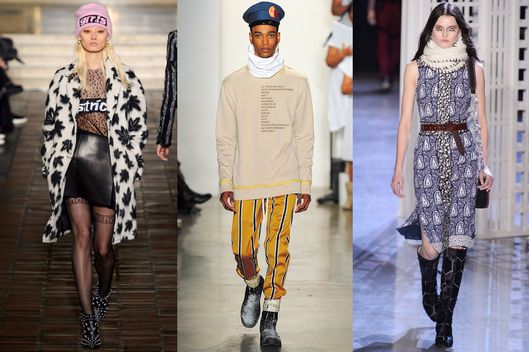
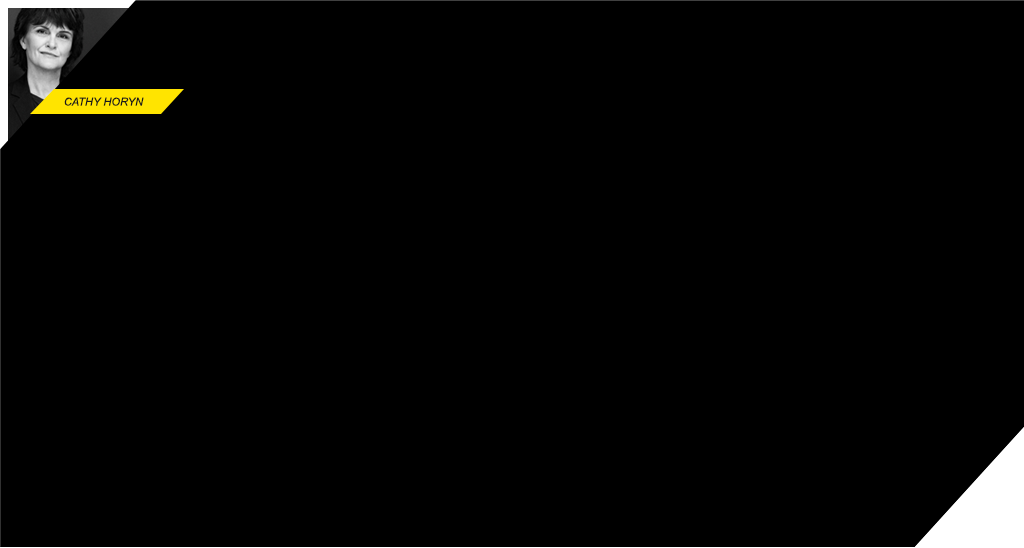
Alexander Wang gives off the impression of a very manic guy who happens to be in control of his every action. You can almost picture him standing, head cocked to one side, before a giant electronic board, each button and dial representing a cultural bell-ringer: Coachella, goth, weed, bondage, gangster, strippers, incarceration, L.A. He gets to work, turning dials and combining images.
At yesterday's show, staged in St. Bartholomew’s Church on Park Avenue, he seemed to be doing just that. Out came scowling models weaving through the runway labyrinth, in choppy Buster Brown haircuts and dressed in prison-striped minis, sheer tops with censor bars over their boobs, sweaters with pole-dancer motifs, and black lace done in a cannabis-leaf pattern. There was also some groovy outerwear (a washed denim jacket lined in scruffy fleece), and a long gray slinky dress printed with murky celestial dots — or how the night sky in Coachella might look if you’re stoned. In short, the collection was a packaged deal. And Wang ran down the center aisle of the Byzantine revival church, hair flying. Amen.
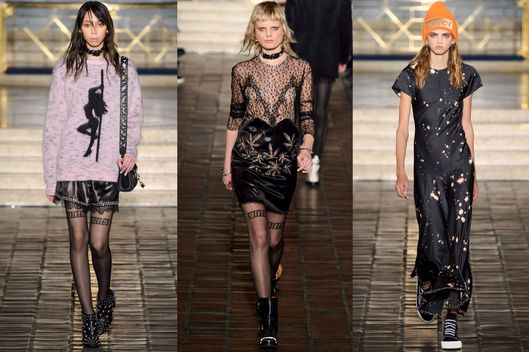
If Wang could push another button on his magic board — "sell now" — this effort would be a clear hit (and it may still be, come late summer and fall). He could move the pot lace and the stripper knits before the joke really begins to look stale, selling for 49.99 at your average midwestern mall-chain. Of course, his other option — and it’s a more challenging one — is to design things that don’t feel so predictable in our image-saturated universe.
Along my bench at the Pyer Moss show, also yesterday, there was a nice wave of laughter when a model came out in a sweatshirt bearing the words, in small print, “You don’t have any friends in L.A.” Oh, the angst of it! I really loved that sharp little dig at the collective paranoia. You have no fucking friends in L.A.
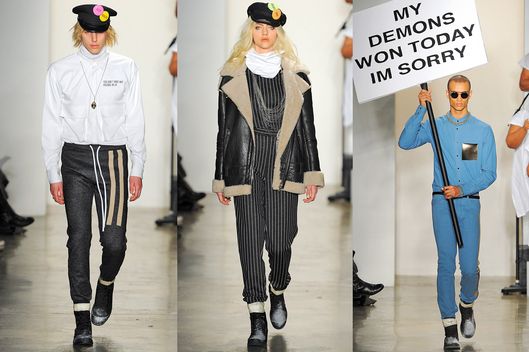
And, what’s more, Kerby Jean-Raymond, the founder of Pyer Moss, did not design any clothes inspired by Laurel Canyon in the 1970s. I consider this a double gift.
Tension is the word I would use to describe the effect of Jean-Raymond’s spellbinding collection, which is mostly for men but includes some things for women — and many looks can be worn by any gender. There’s an unease that seeps through the clothes, in spite of their relaxed style — hoodies, good-looking bulky shearlings, track pants layered with matching shorts — and it’s not because of the message on a sign that appeared at the show’s end: “My demons won today I’m sorry.” Jean-Raymond was making a touching reference to the suicide of MarShawn McCarrel, the #blacklivesmatter activist, just a few days ago, but the collection would work even if you didn't know that reference.
Not to overstate things, but my sense is that Jean-Raymond has a sensitivity for things — intolerance, control, the way the media creates narratives (whether true or false) — and then he seeks to apply that feeling to a design in a way that seems true and subtle. It might be the way a few horizontal metallic strips slightly bind a parka. It might be a lightly quilted pair of overalls, worn with the bib hanging down, that evokes the padded walls of a cell (or, for that matter, a hip lounge in L.A.). Or it might be the stiff, pristine white dickies worn by the models. They looked surgical but also cool.
Jean-Raymond has an instinctive grasp about what works, and he presents you with both modest, desirable clothes and something to think about. What a rare gift that is. For the show, he had a choir, conducted by Sterling Overshown, perform, and their opening piece was an aria set to Future’s “Trap Niggas.”
The first lines were:
“Times still hard but a nigga still getting it
Young rich nigga, in the motherfucker.”
Sung in those beautiful, classical voices, the aria was a reminder that what often releases you from anxiety or someone’s control — or, indeed, the limits of the runway — is the power of art.
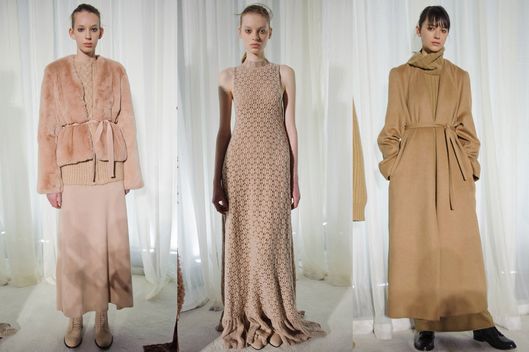
Ryan Roche, a knitwear designer who lives and works in upstate New York, also combined music and fashion, though with a more earthy vibe synced to her clothes. Set up in a corner of a school gym, the teenage band members comprised of two of her three children, and their friends from around Woodstock, mostly did Bowie numbers, while Roche presented her models and served Champagne. She said her starting point for the line was seeing some Peter Lindbergh images of late-1980s minimalism — in other words, in its glory years.
Roche has upped her game this season, with more precise shapes both in concept and execution, and there’s generally a stronger feeling of need. Done in cosmetic shades of pink, cream, and beige with a bit of black, the best looks included minimally cut wrap coats, a wool lace dress, and new short cuddle coats in French rabbit.
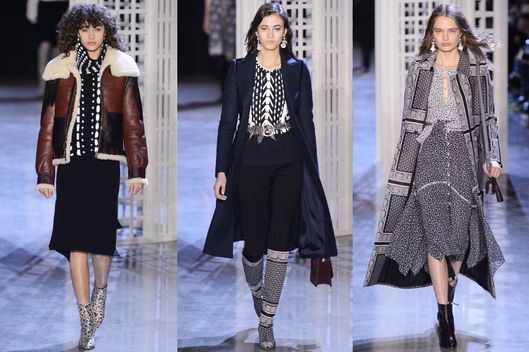
You have to wonder how big the market is for slacker slacks, furry scuffs, and pot motifs (the Baja East label had them, too). To his credit, and our relief, Joseph Altuzarra is not tempted to follow that particular track. “That’s never been my thing,” he said backstage before his terrific show. First of all, the collection nicely balanced the polished with the everyday wearable — for example, a snug-fitting shearling jacket or black-ribbon-woven cream sweater worn with a not-too-narrow skirt, cut with a slight asymmetrical hem. (Ladies, this skirt, shown in Look No. 1, is a keeper.) Other styles that expressed that balance were an A-line navy wool coat with a back of velvet and soutache embroidery, and a number of looks that combined tiny floral or paisley prints (or the same patterns in jacquards).
The mostly dark florals, which vaguely hinted of patterns that were very popular in the mid-19th century, stand apart from all the urbanwear we’ve seen this season, and yet, like the rest of Altuzarra’s collection, they’re hardly uptight. He also carried over the graphic mix of patterns to evening dresses — swirling, handkerchief-hemmed skirts sequin-embroidered in paisley and foulard designs, and worn with low-heeled boots.
If I had any friends in L.A. I'd want them to dress in this collection.
To be fair, it was a 13 foot-long dress.
You and Rihanna Will Both Want to Invest in Dior’s New BagIt's got something for everyone.
Polo Shirts Have Turned Their Back on Ryan LochteAlong with his other major sponsors.
Ryan Lochte Will No Longer Be Paid to Wear Tiny Bathing SuitsSpeedo remains committed to transparency.
Laura Brown Is the New Editor-in-Chief of InStyleAfter 11 years at Harper’s Bazaar.
Tyra Banks Is Going to Teach a Class on Smizing at Stanford"If I see somebody not paying attention, I’m gonna call on them."
This Floating Pier Is the Most Zen Installation EverWalking on water in Italy.
Nation Is Appalled by Matt Lauer’s Nude Ankles During Ryan Lochte InterviewWhat’s the opposite of “Jeah”?
8 People at the Life of Pablo Pop-up Explain Why Kanye West Is a God"I mean, Kanye West is just Kanye West. There's not more or less you can say about Kanye West. He's just Mr. West!"
A T-shirt Is EnoughSimplicity, versatility, and cool. What more could you want?
She took a perfect pencil dive off a 30-foot yacht.
American Apparel Is Being Sued by Former WorkersAs the company considers putting itself up for sale.
A Gendered History of the Tailored SuitFrom Marlon Brando to Coco Chanel.
How Zendaya Developed Such Great Style at the Young Age of 19The star's best looks from Disney to now.
Proof That If You’re Chic Enough, a Little Federal Investigation Doesn’t MatterIs this the best they could do?
5,300-Year-Old Mummified Iceman Probably Would’ve Been a Street-Style StarHe had several different looks and was “pretty picky.”
J.Crew Has Identified 226 Shades of PinkEven more than there are shades of gray.
Gigi and Bella Hadid Merch Is Now Somehow a Thing That Is HappeningToday in Hadidiana.
Gird Your Loins for the Return of Yeezy to New York Fashion WeekThe season approaches.
This Indie Brand Had a Great Response to Ivanka TrumpWhen she bought one of their cuffs, they donated the proceeds to the Clinton campaign.